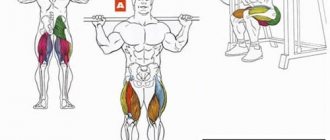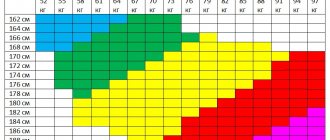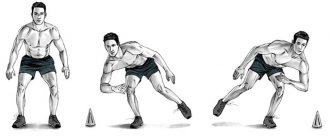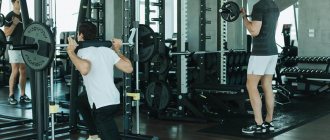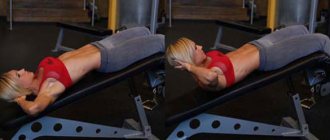What is running with weights?
The athlete puts on weights. They are found on the arms, legs and waist. There are also special vests that are very similar to special forces ones. Internal weights, usually sand or heavy plates, that can be removed and inserted to adjust the load. In addition, some people run with regular dumbbells in their hands or with backpacks.
Each option has its advantages and disadvantages. And, it should be noted that studies on the effects of running with weights have yielded mixed results. Some studies show that gaining weight does not help. Other studies show that weights help, but only when used correctly. In this article, we'll look at the two most common methods of running with weights. We will talk about their advantages and disadvantages. As with all things fitness-related, runners should consult with a doctor or trainer before starting anything new.
Ankle weights
Ankle weights are the first thing most runners think of when they think about running with weights. But this, unfortunately, is also the most dangerous method. The danger of ankle weights lies in the same qualities that made them so popular. Runners strap weights to their ankles using adjustable straps. They can change the weight according to their fitness level. But it puts all the weight on the ankle. Ankles are sensitive joints, and the added weight can cause serious injury.
Runners who want to use ankle weights should do so very carefully. They should consult a doctor or trainer before using weights. As with all resistance training, it's best to start with light weights to avoid injury.
Weighted vests
A newer addition to weight running is weighted vests. They work on the same principle as ankle weights, but with the added stress focused on the person's core rather than their ankles. This does not mean that weighted vests can be used without danger to health. They are a safer alternative.
Weighted vests are ideal for several specific groups of athletes. These athletes are those who focus on explosive strength and bodyweight exercises. Most instructors suggest that people start training with a vest that is 5% of their body weight. However, specific training methods vary depending on the athlete's goals.
What types of weights are used for running?
The most important parameter is the weight, which should be firmly attached to the body and should not move, knock or interfere with free movement. Often used:
- Special cuffs on the legs and arms, plates.
- A sandbag is cheap.
- Vest with weight pockets.
Plate weights
Plate scales are cuffs, belts or vests with pockets for iron plates. Their advantage is that the weight can be changed at will. Such weights are stronger and more durable than bulk ones, but their cost is much higher.
Bulk weights
Volumetric weights consist of dense fabric filled with sand or earth. They are cheaper than plate ones and are suitable for samples. But their main drawback is that the weight cannot be adjusted. According to some athletes, such weights are short-lived, as the fabric begins to wear out and the sand spills out.
Hand bracelets
The bracelets are made of elastic or rubberized fabric. Cuffs made of thick knitwear are not durable. Their width is usually 10-15 cm, the length is adjustable with Velcro. Weight can range from 0.5 to 5 kg.
Dumbbells
You can also use regular dumbbells or dumbbells with a special attachment. Runner-friendly weight.
Additional weight in the hands shifts the center of gravity, forcing the load to be redistributed to other muscles. Running with dumbbells in your hands increases the load on the biceps, as well as the trapezius and deltoid muscles.
Bracelets and dumbbells increase the load on all muscle groups. But after training, the athlete usually feels pain in the shoulder girdle, arms and upper back.
Running with a load will be necessary for those who want to increase the load, as well as engage in boxing or other martial arts. Runners who have back or joint problems may want to stick to just running.
Ankle weights
The weight for the legs differs from the cuffs only in length and width. It is worn on the ankle just above the boot and fits securely on the foot. Make sure that the weight on your leg does not rub or slide on your ankle.
Running with weights on your feet is a job of the sole, shin, and ankle. Unlike a vest, leg weights reduce stress on the spine by working through the columnar muscles of the spine. This exercise works the straight and oblique abdominal muscles.
Weight vest
It's on the top of the body and resembles a bulletproof vest with multiple pockets for weight. The weight of the vest is adjusted depending on the type of activity and tasks that the athlete sets for himself. If you need to do endurance exercises, the weight will be 2.2 kg.
It is better to run with weights whose weight exceeds the athlete’s weight by no more than 5%. By increasing the load evenly, you will avoid injuries to bones and tendons.
Weighted belt
A belt is another type of weight that is lightened by a vest. The belt is securely attached and does not interfere with the athlete’s movements. The running belt allows you to pump up the muscles of your legs, abdomen, buttocks and waist. Tips for choosing a weight are similar to choosing a vest.
Backpack like weight
Most often, marathoners and long-distance runners use a backpack as weight. The sports backpack is protected by adjustable chest and waist straps. Running vests and backpacks provide high-quality ventilation and moisture removal.
When choosing a backpack, pay attention to the position of the straps: they should be adjacent to the body with their entire plane, and not just one edge. The usual weight is 3 kg.
The benefits of running with weights
- Running with heavier weights increases the intensity of your workout. Muscles work more actively and get tired faster. At the same time, more calories are consumed than during regular running.
- Running with weights the night before a race is a great way to improve your endurance. Once a runner gets used to running with more weight, it will be easier to push through the distance.
- Running with extra weight builds the leg strength needed for a powerful snatch or high jump. This exercise also increases the runner's speed over the course.
- Weighted running allows you to reach muscle fatigue over a shorter period of time.
- If you are looking to improve your definition, weighted exercises are for you.
Features of running with weights on your legs
There are two main features of running with weights – it makes running harder; the result will appear faster. Regardless of the weight of the weights, the inertia of the body increases - it is more difficult to stop and it is more painful to fall.
Who is it suitable for?
Running with weights can be divided into jogging for recreational and sports purposes. The farther the load is attached from the center of gravity, the more load is placed on all organs. Therefore, 1.5 kg on the legs corresponds to 8-10 kg on the belt.
On average, by running with weights, you can lose extra pounds 3-5 times faster, that is, you can do it not for 1 year, but for 2-4 months, or run not for 1 hour, but for 12-15 minutes a day.
In almost any dynamic sport, jogging with weights on the legs, to one degree or another, is included in the general training program. For those who occasionally go on long hikes, this is a good opportunity to combine running exercises and exercises in the gym to pump up all the muscles of the legs and thighs.
What will this run give?
- Accelerates the delivery of oxygen to the cerebral cortex.
- Strengthens the cardiovascular system.
- Accelerates fat burning.
- Ensures uniform pumping of muscles.
- It will increase endurance, which means improved athletic performance and relief from shortness of breath.
- Increases propulsion (explosive moment of the legs) - useful for those who engage in long and high jumps, for those who overcome obstacles while running and for cyclists who tend to ride in lower gears.
- Attractive aesthetic appearance of legs. You can show off on the beach, in the bathhouse, solarium, etc.
What muscles work?
It is running with weights that allows you to pump up the soleus and ankle muscles, and this is very difficult to do on simulators.
The calf muscles, the muscles of the front and rear thighs, and the rectus and oblique muscles of the lower abs also work. Weights on the legs put less stress on the spine, while the columnar vertebral muscles are pumped.
Advantages
- short duration of races.
- complex development of the legs, thighs and abs, including the muscles of the spinal columns.
- 5 times more kilocalories are burned than during regular running. Nutrients, unlike ordinary running, are absorbed not so much in the fat layer, but rather transferred to myofibrils (muscle fiber protein).
- saving time on distributing the number of approaches and repetitions and resting between exercises to pump up the leg muscles.
Flaws
- Before you start running with weights, you need to run without them for at least six months to prepare your muscles for additional loads.
- Running with weights is contraindicated for those with high blood pressure and problems with the cardiovascular system.
- Such running has a detrimental effect on the knee joints.
- Incorrect selection of weights can lead to injury.
Who doesn't need weight training?
- Firstly, for beginners. By adding additional weight to a fragile body, a novice athlete risks injury to the back or knees. In addition, it can ruin your running technique, which is not really established.
- Secondly, running with weights is contraindicated for people with cardiovascular diseases. And also with injuries to the knee joints and spine.
- Thirdly, those who want to lose weight. If your body fat percentage is low, then running with weights for weight loss will obviously help. But if we talk about ten kilograms, then the torment will be in vain.
Running with weights – no, general physical training – yes
Alena Dyatlova, leader and coach of the Time4run running club:
Running with weights is a definite no! I am categorically against running with weights and dumbbells. Running itself puts a fair amount of impact on our bodies, and as recreational runners, it's best for us to think about how to reduce it rather than increase it. The fact is that many of us do not follow the regime of professional athletes and, despite good general physical shape, probably have a couple of kilograms of excess weight. That is, we are already carrying dumbbells and weights! Therefore, I would not recommend loading yourself with additional weight while running. And what I would do with cuffs and dumbbells is general physical training.
Having previously worked out all the complexes with your own weight well, you can add weighting. Lunges, walks, jumps, and weighted squats will make you stronger and faster. And doing balance exercises with a small load will help you resist any severe fatigue, from which your technique breaks down while running, and it seems that you no longer have the strength to run.
I would also recommend static and dynamic exercises with resistance, i.e. using various elastic bands and harnesses: this can be running in place or running in a harness. Well, if you suddenly decide to prepare for a short sprint, then you can run with a parachute and with a tire on the back. But that's a completely different story!
Subscribe to “Marathon Man” on Telegram. Announcements of articles and useful selections every week.
Recommendations for running with weights
- It is recommended to warm up before you start running. Too much weight on cold muscles and ligaments - 80% chance of injury.
- Gradual weight gain.
- Start by walking with weights. Include squats, lunges, and weighted leg swings in your warm-up.
- Listen to your body. If you feel tachycardia, rapid breathing, discomfort in the joints and muscles, it is recommended to reduce the load.
- Follow proper running technique. This is the key to healthy joints.
Share link:
5 / 5 ( 10 votes)
Can you lose weight while working out or running with weights?
Many people wonder if running or walking with a weight will help you lose weight. Unfortunately, the response is not faster than usual. On the one hand, as the load increases, you will increase energy consumption. But if excess weight exceeds 5% of body weight, the effect will be almost unnoticeable. The fact is that burning fat requires a number of factors: maintaining a low calorie intake in the diet, having sufficient muscle mass (which is always energy-intensive and does not “repel” fat) and a certain type of exercise.
Extreme cardio (which includes regular running) at a high heart rate, as well as heavy weight lifting, helps you lose weight. Running with weights is not enough to sustain the load for a long time. This means that not much fat is burned this way. With this in mind, it can be concluded that running or walking with weights is not the best tool, although it can be used as a component of a fat loss program.
It should also be taken into account that the load of running and walking does not stimulate muscle tissue. And one more important note: it is almost impossible to pump up your butt, which is what women dream about. The main load on the front surface of the legs, as well as on the back surface of the lower leg, is the biceps of the legs and calf muscles.
Pros and cons of running with weights
If you specialize in running, you don't need to use weights. They require special preparedness and will only interfere with the development of correct running technique, make breathing difficult and cause pain in the joints. It's helpful to use weights if you're running to lose weight. Running forces the body to seek additional sources of energy to block the lack of oxygen. Since it burns fats and carbohydrates, it helps you lose weight.
If you use weights for additional exercise, the process of burning calories will become easier, and you can lose weight in just a couple of months of exercise.
Lifting weights for bodybuilding will also work. This will help develop the heart, improve blood circulation and metabolism, which contributes to the appearance of muscle relief.
Weights will also promote rapid growth of leg muscles. All you need to do is perform the exercises correctly so that all your muscles develop proportionately.
This type of running is recommended for athletes who need high speed. And it's not just sprinters. High speed is needed not only by long runners, but also by throwers, football and basketball players, and many others.
Hurdlers or steeplechase runners will need a lesson - this will develop leg strength and will also help with hurdles. Endurance will give excellent results for long-distance runners, athletes who participate in extreme types of running - climbing into the sky or covering distances in the mountains.
The main disadvantage of performing exercises with weights is that they negatively affect the joints. In particular, on the knee joint - many novice runners who decided to develop endurance in this sport have recently complained of knee pain.
Therefore, do not try to strain yourself too much on the first day of training by putting iron plates on your legs. It won't do anything good. Start doing the exercises gradually, be patient, and you will feel when you can start doing more difficult work - running with heavy loads.
Types of weights
The simplest type of weights are small dumbbells, just hold them in your hands while working out. This will force you to work not only your legs, but also your arms. Such weighting contributes to the formation of correct running technique and helps to hold the body.
But if running with additional weight is not a momentary whim, buy special weights. These can be considered weights for legs and arms in the form of cuffs with ties and Velcro, with which they can be easily secured to the wrists and shins. There is also a weighting material for the body in the form of a vest. Special weights are good because their weight can be adjusted using special metal plates. This is the best option for gradually increasing the load by adding weight.
All the types of weights mentioned above serve as an additional load on the joints and spine, so you cannot use them thoughtlessly; there are a number of recommendations and contraindications that should be strictly followed. The most important criterion, as always, is your well-being. To understand whether you can run with weights, arrange a test outing - a walk with the desired set to immediately dot the i’s.
You should start running with a warm-up; warm up your leg muscles with squats and lunges, and your arms with swinging movements. Don't skip warming up your joints. Without warming up, your running routine can cause injuries and joint problems in the future. A short run with maximum acceleration is good for warming up. Remember, running with weights is not fun, it is a dangerous workout, and a serious warm-up can save you from possible problems!
